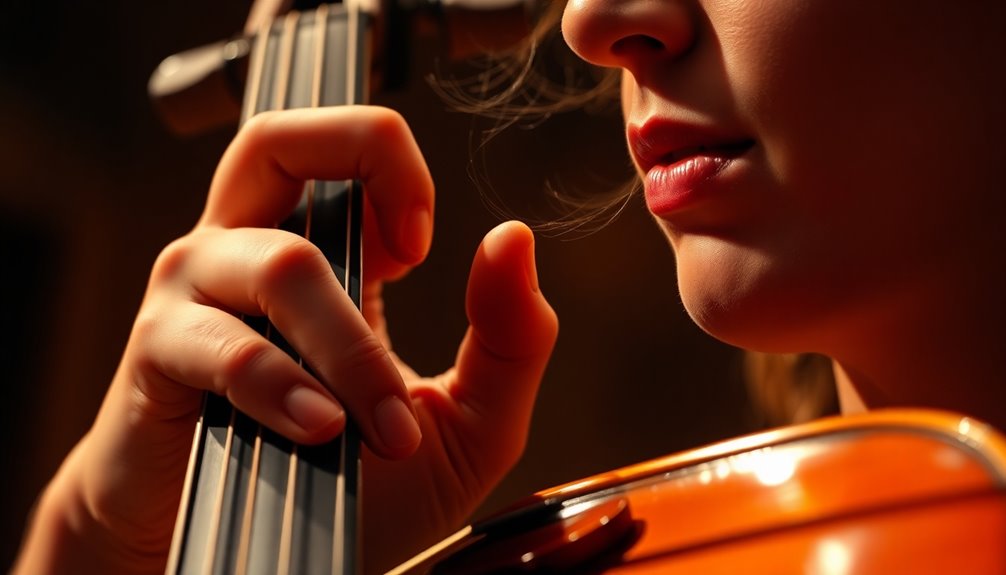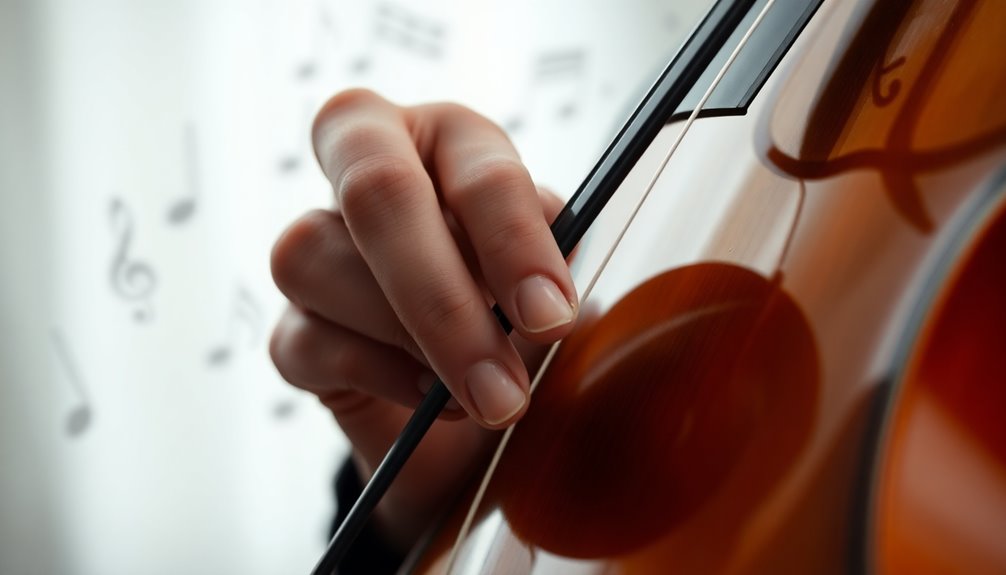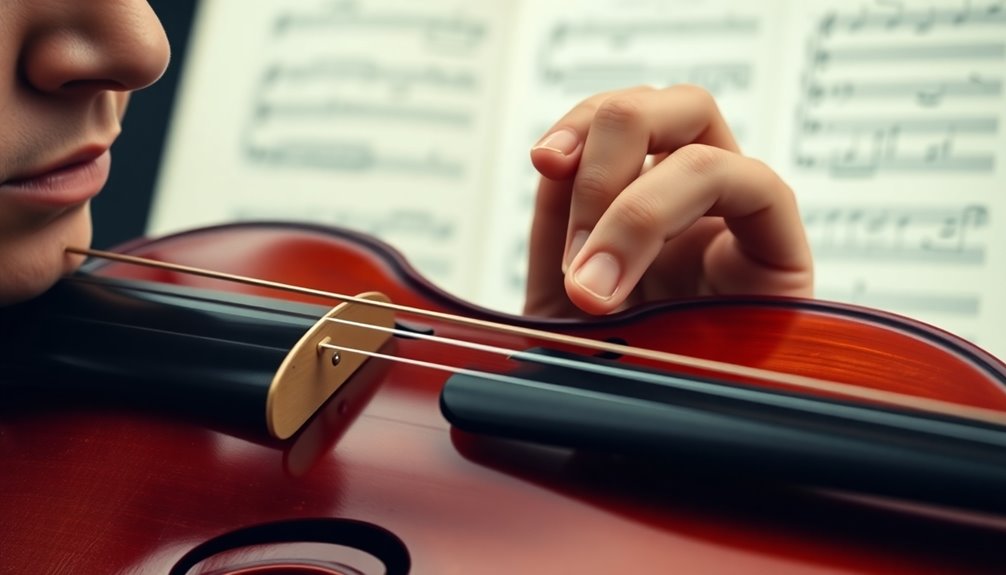Exploring vibrato techniques can truly transform your expressive performance. Start by understanding the different styles, like diaphragmatic and finger vibrato, each offering unique emotional qualities. Controlled oscillation involves practicing speed and width to find the right expression for your piece. Don't forget the importance of breath support; it's essential for maintaining steady vibrato while you play. Also, be mindful of common mistakes, like overusing vibrato or neglecting musical context. Mastering these elements can enhance your artistry, allowing your performances to resonate deeply. With dedication, you'll uncover even more strategies to truly elevate your musical expression.
Key Takeaways
- Experiment with different vibrato types—diaphragmatic, finger, and lip vibrato—to find the best fit for your emotional expression in performance.
- Practice long tones while gradually adjusting vibrato speed and width to develop control and muscle memory for authentic expression.
- Incorporate breath support techniques to enhance vibrato's dynamic quality and maintain a resonant sound throughout sustained notes.
- Analyze the emotional context of the music to inform appropriate vibrato speed and width choices, enhancing storytelling through performance.
- Identify and emphasize key moments within a piece where vibrato can add emotional depth, ensuring it complements the musical intent.
Understanding Vibrato Basics

Understanding vibrato basics is essential for any musician looking to enhance their performance. At its core, vibrato is a controlled oscillation of pitch that adds warmth and expression to your sound. This technique can transform a simple note into an enthralling musical experience. By mastering vibrato, you not only enrich your performance but also connect more deeply with your audience.
Vibrato's history traces back centuries, evolving through various musical styles and cultures. Originally, it was primarily used in vocal music, where singers employed it to convey emotion. Over time, instrumentalists adopted vibrato, making it a standard technique across many genres. This shared journey through music history creates a sense of belonging among musicians, as you're part of a legacy that spans generations.
As you explore vibrato, consider the importance of practice and patience. It's not just about the mechanics; it's about finding your unique voice within this technique. Start by experimenting with different speeds and widths of vibrato to see what feels authentic to you. Regular practice of specific vibrato exercises can enhance skills and styles, establishing a steady foundation for your technique.
Remember, the goal is to enhance your expression without overshadowing the melody.
Embrace vibrato as a powerful tool to communicate your emotions and tell your story through music. By understanding its definition and embracing its rich history, you're not only improving your skills but also joining a vibrant community of artists who share your passion.
Types of Flute Vibrato

Exploring the various types of flute vibrato can discover new dimensions in your playing. Each flute vibrato style has its unique character, and understanding these can enhance your expressiveness. The most common types are diaphragmatic, finger, and lip vibrato.
Diaphragmatic vibrato involves controlling your breath support, creating a wave-like motion that adds depth to your sound. This style is often favored for its smooth, consistent oscillation, making it ideal for lyrical passages. To practice this, try vibrato exercises focusing on varying your air pressure while maintaining a steady tone.
Finger vibrato, on the other hand, utilizes rapid finger movement to create a pitch variation. This technique can add a playful, lively quality to your performance. It's especially effective in faster passages. To develop this style, incorporate finger vibrato exercises, focusing on maintaining a relaxed hand while achieving a clean, rapid motion.
Lastly, lip vibrato is created by subtle changes in your embouchure. This style can produce a warm, rich sound, perfect for emotional pieces. Practicing lip vibrato requires mindful attention to your mouth position and airflow. Additionally, mastering articulation techniques can further enhance the expressiveness of your vibrato, allowing for greater emotional depth in your performance.
Developing Controlled Vibrato

While mastering vibrato can elevate your flute playing, developing controlled vibrato requires focused practice and patience. Start by understanding the basic mechanics of vibrato. Controlled vibrato is about creating a consistent, even oscillation in pitch that enhances your musical expression.
To achieve this, you'll need to engage in specific vibrato exercises designed to build muscle memory and control. Begin with a slow, steady pulse. Try using a metronome set at a comfortable tempo. You can practice by alternating between whole notes and quarter notes, allowing your vibrato to develop naturally within each note.
As you gain confidence, explore different vibrato styles, such as wide or narrow vibrato. Each style adds a unique flavor to your playing, so don't hesitate to experiment and find what resonates with you.
Another effective exercise is to play long tones while gradually increasing and decreasing the speed of your vibrato. This helps you gain control over the intensity and speed, essential for expressive performances. Utilizing a metronome's tempo range can significantly enhance your practice by providing a structured environment for your exercises.
Record yourself to hear your progress and identify areas for improvement; it's a great way to stay motivated.
Breath Support for Vibrato

Controlled vibrato not only enhances your musical expression but also relies heavily on effective breath support. To achieve that enchanting vibrato, you need to master breath control, which allows you to sustain notes with a dynamic, resonant quality. By engaging your diaphragm properly, you can create a steady stream of air that fuels your sound and keeps it vibrant and alive.
Start by focusing on your breathing technique. Take deep breaths that fill your diaphragm, not just your chest. You want to feel your abdomen expand as you inhale. This engagement of your diaphragm is essential; it gives you the strength and stability needed for expressive vibrato.
When you exhale, maintain that control to avoid a rushed breath, which can lead to an uneven sound.
As you practice, try to connect your breath with your vibrato. Experiment with different tempos and widths of vibrato while paying attention to how your breath supports these variations. Incorporating diaphragmatic breathing techniques enhances your ability to control airflow, allowing for even more expressive vibrato.
You'll notice that a relaxed yet engaged diaphragm allows for more flexibility in your vibrato, resulting in a richer, more emotional performance.
Finger Technique and Vibrato

Mastering finger technique is crucial for developing an engaging vibrato. Your fingers are the bridge between your intent and the music you create, so focusing on finger agility is key. This agility allows for fluid movement across the strings or keys, enabling you to execute vibrato with finesse and precision. When your fingers can move effortlessly, it frees you to express emotions more deeply, connecting you with your audience.
To enhance vibrato coordination, practice exercises that isolate finger movements. Start slow, ensuring each finger can articulate notes clearly before introducing vibrato. Gradually increase speed while maintaining control. You'll find that as your finger agility improves, so does your ability to incorporate vibrato seamlessly into your performance.
It's also crucial to be aware of how your entire hand interacts with your instrument. Keep your wrist loose and relaxed, allowing your fingers to pivot naturally. This holistic approach not only aids in vibrato technique but also contributes to a more expressive sound overall. Additionally, developing your breath control can significantly enhance your ability to sustain notes while incorporating vibrato.
As you refine your finger technique, remember that every musician's journey is unique. Embrace your progress, celebrate small victories, and don't hesitate to seek feedback from peers or mentors. Together, you can cultivate a sense of belonging within your musical community, sharing tips and techniques that elevate everyone's performance.
Vibrato Speed and Width

Vibrato speed and width are essential components that can dramatically shape the emotional character of your performance. Mastering these elements allows you to create vibrato variations that resonate deeply with your audience. Here's what you should consider:
- Speed: The tempo at which you oscillate your pitch can convey different feelings. A slower vibrato often evokes warmth and tenderness, while a faster vibrato can inject excitement and urgency into your sound.
- Width: This refers to the extent of pitch variation in your vibrato. A wider vibrato can add richness and drama, while a narrower vibrato may offer a more focused and precise tone. Finding the right balance is key to expressing your musical ideas effectively.
- Context: Different musical styles or pieces may call for specific vibrato dynamics. Consider the genre and emotional context to decide the ideal vibrato speed and width that will enhance your performance.
Experimenting with these components not only enriches your sound but also connects you more intimately with your listeners. Practicing scales can increase finger coordination by up to 30% in weeks, which can further aid your vibrato development.
Embrace the journey of exploring vibrato dynamics, and don't shy away from pushing your boundaries. The beauty of vibrato lies in its ability to reflect your unique voice as a musician.
Incorporating Vibrato in Phrasing

Integrating vibrato into your phrasing can elevate your musical expression and create a more engaging performance. When you incorporate vibrato dynamics into your interpretation, you're not just adding decoration; you're enhancing the emotional depth of your music. Think of vibrato as a tool that allows you to emphasize certain notes and convey expressive nuances that resonate with your audience.
To effectively incorporate vibrato into your phrasing, start by identifying the moments in your piece that would benefit from this technique. Typically, sustained notes or climactic phrases are prime candidates. As you practice, experiment with varying the width and speed of your vibrato. A wider vibrato can add intensity, while a narrower one might offer subtlety. This experimentation allows you to discover how different vibrato dynamics affect the overall feel of the passage.
Remember that vibrato should enhance your musical intent, not overshadow it. When you connect your vibrato to the emotional narrative of the piece, it becomes a powerful means of storytelling. Think about the feelings you wish to evoke in your listeners; allow your vibrato to reflect those emotions. Developing a consistent vibrato requires mastery of advanced techniques, which can be achieved through dedicated practice and targeted exercises.
As you blend vibrato with your phrasing, you'll find your performance becomes more genuine and relatable. This not only nurtures your growth as a musician but also fosters a deeper connection with your audience. Embrace these techniques, and let your vibrato become an extension of your artistic voice.
Common Vibrato Mistakes to Avoid

Expressing musicality through vibrato can be a delicate balance, and many musicians unknowingly fall into common pitfalls that hinder their performance.
To truly elevate your sound, it's essential to recognize and avoid these mistakes:
- Vibrato Overuse: Using vibrato on every note can dilute its expressive power. Instead, save it for moments that need emotional emphasis, allowing the natural pitch to shine through in other passages.
- Inconsistent Speed and Width: A shaky vibrato can confuse listeners. Aim for a steady oscillation in both speed and width. Practice slowly to develop a consistent and controlled vibrato that enhances your musical phrases.
- Ignoring Context: Different musical styles require different approaches to vibrato. What works in a romantic piece may not suit a baroque work. Always consider the style and mood of the piece to guarantee your vibrato complements the music, rather than overshadowing it. Additionally, incorporating mindfulness techniques during practice can help refine your vibrato by promoting awareness and control.
Frequently Asked Questions
How Does Vibrato Impact Emotional Expression in Music?
Vibrato greatly enhances emotional expression in music by adding depth and richness to your sound.
When you use vibrato nuances, you create emotional intensity that resonates with listeners. It allows you to convey feelings that mere notes can't express, drawing your audience into your performance.
Can Vibrato Be Applied to Other Instruments?
Absolutely, you can apply vibrato techniques to various instruments!
Whether you're strumming a guitar, bowing a violin, or even playing the flute, incorporating vibrato can elevate your sound. It adds depth and emotion, making your performance more engaging.
By experimenting with vibrato applications in your instrument techniques, you'll discover unique expressions that resonate with your audience.
What Is the Historical Context of Vibrato in Flute Music?
Vibrato in flute music has fascinating historical roots. It originated in the Baroque period, where it was used sparingly to enhance expression.
As you explore the Romantic era, you'll notice its evolution—flutists embraced a wider, more expressive vibrato, enriching their performances.
Understanding this journey not only deepens your appreciation of flute music but also connects you with a community of musicians who share your passion for expressive artistry.
Are There Specific Exercises to Improve Vibrato?
Yes, there are specific vibrato exercises that can enhance your technique.
Start by practicing finger technique; try slow, controlled movements to maintain a steady airflow. Incorporate a metronome to regulate your timing.
Gradually increase speed while keeping your vibrato even and consistent. You might also experiment with different finger placements, discovering what feels most comfortable for you.
How Does Vibrato Differ Across Musical Genres?
Vibrato styles can vary considerably across musical genres, reflecting each genre's unique influences.
For instance, classical music often features a controlled, wide vibrato, while jazz might embrace a more expressive, narrow approach.
In folk or rock, you might find a raw, emotional vibrato that connects deeply with listeners.
Understanding these differences can inspire you to explore and adapt your own vibrato, adding richness to your performances and enhancing your connection with your audience.
Conclusion
In the quest for the perfect vibrato, you might think you need to master every technique outlined here. Ironically, it's often the simple, heartfelt moments that resonate most with your audience. Embrace the journey of exploration, and don't fret over perfection. By integrating vibrato into your phrasing naturally, you'll find that your expressiveness shines through effortlessly. So, let go of the pressure, trust your instincts, and watch your performance transform into something truly memorable.






